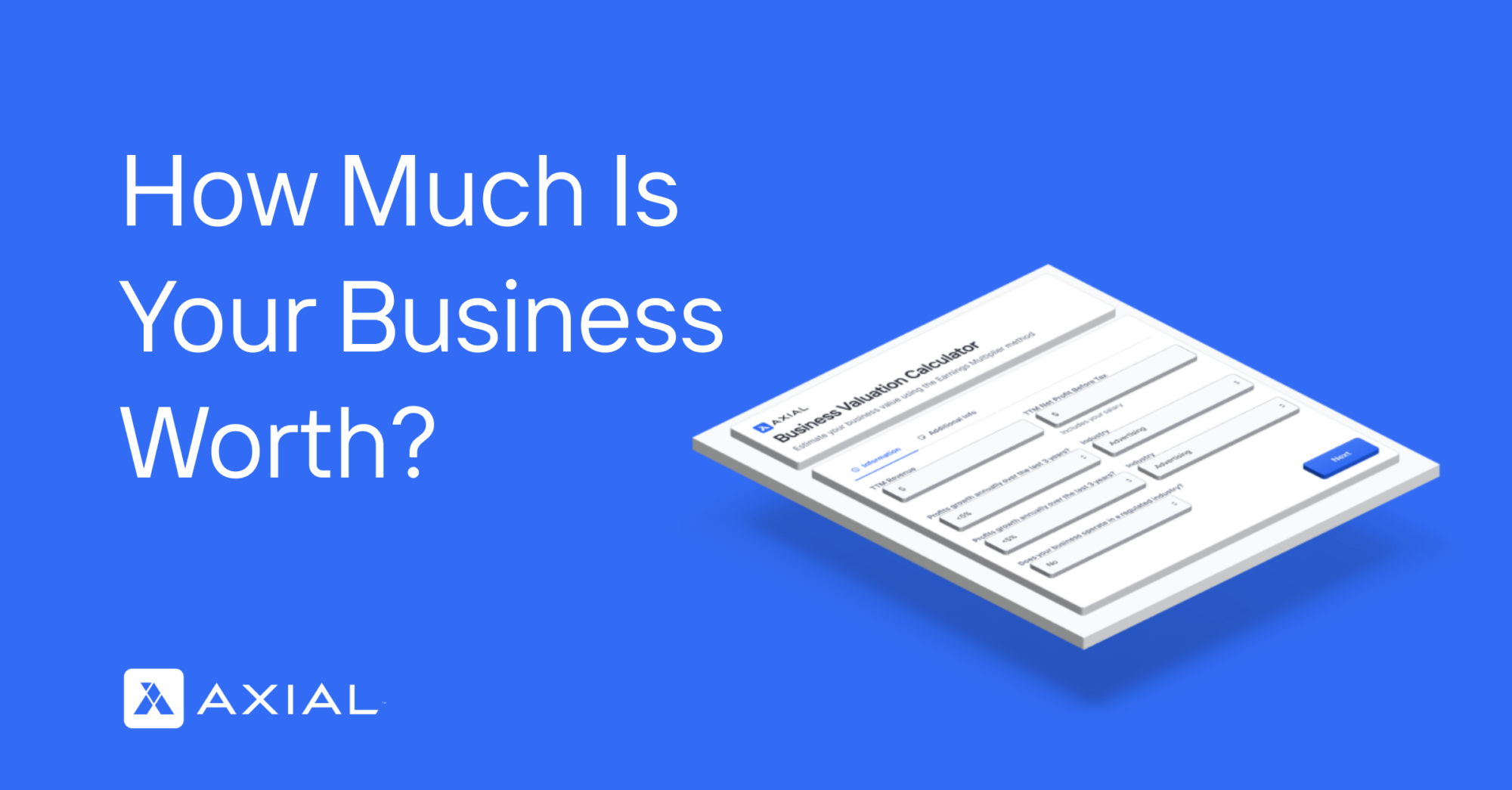
Introducing Axial’s Business Valuation Calculator – Find Out How Much Your Business Is Worth
The number one question our exit consultants hear from business owners is: “How much is my business worth?” To help…
Business value reflects the overall worth of a company, determined by its financial performance, operational efficiency, and market position. As a business owner, you may aim to maximize value for various reasons, including:
Regardless of the reason, maximizing your business value requires a strategic approach, thoughtful planning, and execution.
In this article, we’ll focus on maximizing business value in the context of a sale.
Below, we outline five key strategies that can significantly enhance your business’s valuation:
The first four strategies aim to increase revenue, reduce costs, and improve operational efficiency, providing the foundation for a more valuable business. The final strategy — targeting the right buyers — is a crucial step in the sale process, often executed with the help of an M&A advisor.
Before diving into these strategies, it’s important to first understand how your business is valued.
There are two primary ways to get an accurate business valuation:
If you’re seeking a business valuation but aren’t actively planning to sell, it may be more practical to work with a valuation analyst. Several types of certified analysts can conduct a business valuation, including:
But if you’re already on a timeline to sell your business or committed to the idea of selling, getting a valuation from an M&A advisor is the smarter move. Unlike generic valuation providers, an advisor brings deep expertise of your industry’s M&A landscape, ensuring your business is valued in the right market context. This positions you far more effectively when it’s time to attract buyers and negotiate a deal.
An experienced advisor not only provides an accurate valuation but also maximizes your deal potential by identifying the right buyers, articulating the strategic value of your business offers, and negotiating the best price and terms.
If you’re ready to sell, we can help you find the right M&A advisor.
Whether you choose to work with an accredited valuation analyst or an M&A advisor, it’s important to understand how they will determine your business’s valuation range.
They’ll use three different analyses to triangulate the most accurate value of your business:
1. Discounted Cash Flow (DCF) Analysis
This method estimates the value of a business based on its expected future cash flows. It involves forecasting the profits your business will generate and then “discounting” those cash flows back to their present value using a discount rate. The discount rate reflects the risk and predictability of your business’s future profits, adjusting for inflation to indicate how much future profits are worth today.
To conduct this analysis correctly and justify your assumed growth, base your growth rate on historical performance, industry and market conditions, company-specific factors (like brand strength and market share), and macroeconomic factors.
You can use our free business valuation calculator to get an industry-specific DCF analysis of your company.
2. Comparable Company Analysis (Comps)
A comps analysis benchmarks your company’s valuation against similar businesses in your industry, factoring in size, growth, geography, capital structure (including debt levels), and lifecycle stage.
For small businesses, this approach can be challenging, as valuation data is more accessible for larger, publicly traded companies than for smaller, private ones. To obtain an accurate valuation, it’s crucial to select the right set of comparables and adjust for size differences, ensuring a more meaningful and realistic comparison to industry peers.
3. Precedent Transaction Analysis
Precedent transaction analysis values a business based on the prices paid for similar companies in past sales, offering real-world exit valuations. Unlike other methods, this approach accounts for premiums buyers have previously paid, which may include inflated prices from competitive bidding. However, obtaining reliable data can be challenging without the assistance of an advisor or analyst, as most transaction details are kept private.
These three analyses examine key business valuation factors, outlined in the table below. The table also illustrates how these factors typically influence valuation, either driving it higher or lower.
Depending on your exit timeline, some of these factors may be beyond your control when maximizing business value. Next, let’s look at five ways you can influence these factors.
When you work with an M&A advisor, you have someone on your team who can identify the factors influencing your company’s value and can:
As mentioned earlier, all but one of the methods listed below focus on decreasing costs, increasing revenue, and strengthening operational efficiency.
Simply put, your goal is to identify and enhance the elements of your company that drive value, while finding ways to optimize areas of underperformance.
Not all of the items below will apply to your specific business, nor will they all have a significant impact on your business’s value. An M&A advisor can help you pinpoint areas for quick improvements while also highlighting longer-term opportunities that buyers may see value in.
For aspects that require more time to implement, your advisor may present them as growth opportunities to prospective buyers. For example, expanding cross-selling strategies in your eCommerce store or entering a new market where your business has strong potential but hasn’t yet established a presence.
Your customer relationships are the backbone of your revenue — and your business’s value. To maximize your sale, focus on securing long-term agreements, reducing customer concentration, and optimizing pricing & payment terms. This assures prospective buyers of stable, predictable, and timely income even after your exit.
For example, you should:
This shows prospective buyers that your company will offer stable income even after you step away.
Optimizing contracts is especially crucial if you manage sales relationships with key clients. If you leave, clients might follow a competitor, known as “key person risk.” A non-compete isn’t enough to reassure buyers, so reducing this risk is vital for attracting a wider pool of buyers. (We’ll cover this in more detail below.)
In addition to customer contracts, potential buyers will want to review other documents that reflect your business’s value. This includes:
Ensure these documents are free of legal issues and transferrable to the new owner. Without this assurance, your company’s perceived value could significantly decrease in the eyes of prospective buyers.
To maximize your business’s value, consider improving your product or service. This strategy is most effective with an extended exit timeline. Working with an advisor can help demonstrate the growth potential to prospective buyers. For example, you can:
As mentioned, these strategies aren’t always realistic for businesses planning to sell soon. Business owners seeking a short-term exit typically won’t want to invest time or funds into launching a new product in their final months.
However, researching development opportunities is still valuable as you prepare to sell. Understanding potential for growth enables your advisor to highlight this during the sale process, such as in the CIM (Confidential Information Memorandum). Including this information can attract buyers and help justify your valuation range.
Your company’s infrastructure — equipment, supply chains, delivery methods, etc. — directly impacts your bottom line and, consequently, your business’s value.
By reviewing your current infrastructure, you can often reduce costs without committing to major capital investments. For example:
It’s crucial to identify opportunities to reduce costs, working capital, and CapEx needs. These factors are key for many buyers, signaling efficient operations, strong cash flow, and lower financial risk, making the investment more attractive.
In many small and mid-sized companies, a business owner’s knowledge, relationships, and reputation significantly drive value, creating a “key person dependency.”
If you plan a full exit, addressing this dependency is critical to assuring buyers that the business can continue without you. This often involves:
A detailed transition plan shows buyers that your business can maintain operations post-exit. Without it, closing a deal becomes more challenging.
Further reading: Business transition planning: 3 phases for a successful exit
The value of your business ultimately boils down to what someone is willing to pay for it. To maximize this value, attract as many qualified buyers as possible and gauge their willingness to pay, ensuring you get the best price and terms during your exit.
Working with an M&A advisor enables you to implement a comprehensive buyer targeting strategy, which can significantly increase the final sale price. In our experience, business owners who work with an advisor sell their businesses for 25% more than those who don’t.
When you work with an advisor, this boost comes from their expertise in targeting buyers, negotiating, and structuring deals:
Additionally, working with an advisor saves you 30+ hours per week, allowing you to focus on optimizing your business to maximize its value.
Get connected with an Axial Exit Consultant today.
Whether you’re ready to sell your company and putting together a checklist to help you prepare, or you’re simply researching value to lay the groundwork for a transition, a deeper understanding of the factors that drive your business’ value sets you up to make more informed decisions and build toward a smoother exit.
For more information, we recommend these resources from Axial’s Exit Planning Center:
